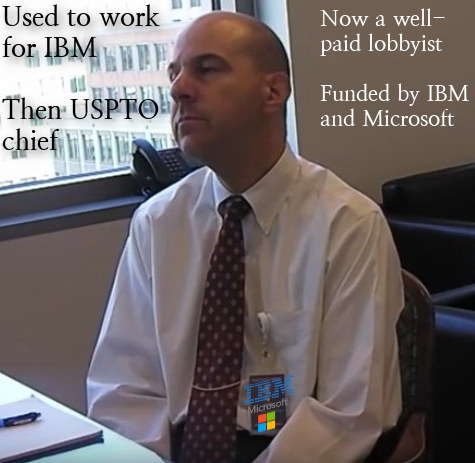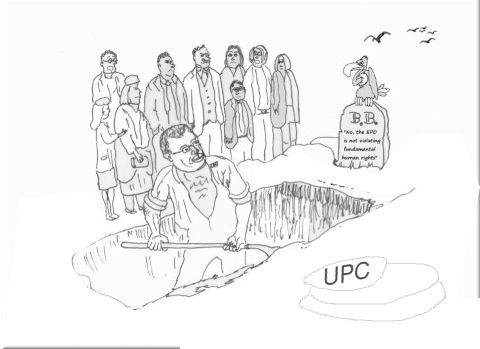11.27.16
Posted in America, Patents at 6:06 pm by Dr. Roy Schestowitz
Progress can be halted and regression soon follow for oligarchy’s sake

Source: David Kappos interview with Intellectual Property Magazine (2010), modified by us
Summary: Just as the USPTO begins to get its act together and limit patent scope based on reasonably liberal SCOTUS Justices there are many reports suggesting that the Director of the USPTO will be driven out, courtesy of the Trump presidency that will also perturb SCTOUS
THE USPTO has a longstanding patent quality problem, albeit with Alice and few other top-level decisions (Mayo for instance) things are improving somewhat.
The other day we found Jaguar Land Rover pursuing patents on facial recognition, which basically means software patents. I have peer-reviewed papers for international journals about this subject; no doubt this is about software patents — possibly a thing that UK-IPO would reject outright. Here is what Britain’s worst paper wrote about it:
Motorists could soon unlock the doors of their car simply by walking up to it and taking a selfie.
Jaguar Land Rover is developing technology that uses facial recognition and gait analysis to detect when owners of its vehicles approach, to open the doors for them.
Details have been revealed in a recently published patent application by Jaguar Land Rover, but it is unclear when the technology might become available.
Nothing innovative here and also it’s about software. Shouldn’t the post-Alice guidelines* at the USPTO disqualify this? How about this other new patent application? It’s one which TechDirt introduced the other day with the headline “Sony Wants To Patent A System For Scoring Journalists’ ‘Veracity’,” noting that it’s too obvious for a patent. To quote directly: “Like anyone wouldn’t have come up with such a system if there wasn’t patent protections?”
“Nothing innovative here and also it’s about software.”Let’s face it, David Kappos has made more of a farce out of this system, having worked for IBM, a big proponent of software patents. Is the leadership of the USPTO ‘on loan’ (to large corporations)? Kappos now works as a software patents lobbyist and IBM is one of his clients. It disgraces the whole patent office on ethical grounds and nobody seems to mind.
Looking at some scholarly figures from Patently-O (published this past week, probably for some paper of his), it seems evident that Kappos did a lot of damage to patent quality. As Patently-O put it: “You’ll note the discontinuous nature of the average-PTA chart. The break-point in early 2010 shows the impact of the Federal Circuit’s Wyeth decision holding that the PTO had been under-calculating the adjustment.”
That’s also the Kappos impact. Here is another new graph. This graph, in our assessment, may simply mean that patent law firms broaden their applications’ “template” (notably with citations) in order to patent some more junk and make it seem credible, well-researched. To quote: “The number of references cited per patent continues to rise, albeit more slowly in recent years. For patents issued in 2016, the average patent includes more than 50 cited references. In my view – this is great, although it would certainly help if the examiner was given some clue as to why the reference is deemed relevant or what portion of the reference is relevant. (If an examiner has a question, they can ask the applicant). A not-surprising facet of the growth in references-cited is that almost all of the growth is in applicant-cited. Compared with 10 years ago, applicants cite 26 more references per patent (on average) while examiners cite only 1.5 more per patent. As you might also note from the difference between median and average – the citation distribution is highly skewed. Example: If we take the top-5% of patents from 2016 (those with the most references cited) – they include 35% of all of the cited references. My experience with this skew is that patent applicants considered more valuable by their owners are more likely to submit more prior art references.”
“Let’s face it, David Kappos has made more of a farce out of this system, having worked for IBM, a big proponent of software patents.”There is another new graph at Patently-O and the way we interpret it is quite simple: Quality of patents at the USPTO (or complexity of patents) is declining. Patent examiners don’t seem to mind. The more, the merrier.
One last post from Patently-O alludes to Donald Trump and notes that the majority of patents in the US are not even from the US. The part about ITC (where the I should stand for US, not “international”) says: “In an email, Prof. Mark Lemley suggests that we should look for “a rise in the importance of the ITC as we focus on blocking imports.” The ITC’s primary goal is to protect U.S. industries against unfair international trade. Lemley writes: “One interesting question is whether Trump will move the ITC’s jurisdiction back to its roots by insisting on a real domestic industry requirement.” Additional ITC movement could push-back against U.S. patents that are owned by foreign nations or unduly subsidized by a foreign nation.”
“He’ll turn the USPTO into a Great Swamp Again.”We criticised the ITC many times. It’s just an apparatus of US protectionism, so the I in the acronym is not suitable, like the W in WTO. Another article about Trump’s impact, this time from MIP, says: “A panel on the US election at the IP Dealmakers Forum speculated that the Trump administration may take a long time to appoint a USPTO director and the Republican leadership that worked on patent bills in the previous Congress will again push for reform” (we already noted that USPTO Director Lee may be on her way out).
We expect Trump to make the US patent system even worse, as corporate interests tend to be prioritised over people, based on his recent appointments. He’ll turn the USPTO into a Great Swamp Again. As for SCOTUS, expect more Conservative Justices there (not just a Scalia replacement), complete with preference for large corporations like Trump’s. █
__________
* According to this new placement in IAM, the “USPTO seeks public comment regarding subject-matter eligibility” (covered here before). To quote: “On October 17 2016 the US Patent and Trademark Office (USPTO) announced that two roundtables will be held in the coming months to discuss patentable subject matter eligibility under 35 USC § 101. The roundtables have been set up to facilitate public comment and discussion regarding the USPTO’s current guidance on subject-matter eligibility as well as case law arising from interpretation of the requirements under 35 USC § 101.”
Permalink
 Send this to a friend
Send this to a friend
Posted in Deception, Europe, Patents at 5:11 pm by Dr. Roy Schestowitz

Summary: Team UPC, a collective of self-serving patent lawyers who produce nothing of substance, hopes that some time tomorrow the UPC will miraculously be revived in Britain even though it’s extremely unlikely
THE Unitary Patent (or UPC) will quite likely have its death reaffirmed tomorrow. Don’t expect Team UPC to admit this though. The UPC-centric bloggers from Bristows will carry on (now there’s “EQE roundup”) and so will the bloggers at Kluwer Patent Blog. We kindly remind readers that these people have a track record of even advertising false jobs, so don’t believe Team UPC and the EPO (chronic liars). It’s their wallet/agenda that speaks.
Thankfully for us, Battistelli cannot quite ‘buy’ the vote (or bribe) the UK for UPC ratification (it would require too big a gift), so the UPC is going nowhere here. Kluwer Patent Blog, a huge proponent of the UPC, cited Bristows (an integral British part of Team UPC) to come up with a bizarre headline that says “Announcement expected about participation UK in Unitary Patent and Unified Patent Court” (as if they already know in advance what will happen). To quote:
According to a Bristows report, ‘the UK Minister of State for Energy and Intellectual Property, Baroness Neville-Rolfe, will state how the UK intends to proceed regarding its participation (or not) in the system’.
Since the Brexit vote, the future of the UP system has been clouded in uncertainty. Ratification by the UK of the UPC Agreement is mandatory for the launch of the system, but after the Brexit vote it seemed this requirement could kill the UP, as it wasn’t sure at all the UK would still be prepared to remain in the new patent system.
There are no signs that Lucy Neville-Rolfe will override British democracy, so we don’t expect much to happen. As for Kluwer Patent Blog, watch the headline it produced two days earlier (merely a quote), seemingly giving instructions from self-serving firms in Italy so as to save the UPC.
Truth be said, the UPC is in a limbo or in a death spiral/crawl. As we saw in TTIP and TPP, nobody in the “inner circles” wants to admit the death until it’s finalised and truly irreversible. Unless it’s redesigned completely, it has no chance. “EU Software Patents future will be decided tomorrow,” Benjamin Henrion wrote, “in the EU Council with the fate of the Unitary Patent,” but nothing will change. The UPC (as we know it, after several other names) is dead and endless lobbying by Team UPC has changed nothing at all, it just exposed Team UPC’s crudeness and disdain for democracy.
“More Brexit foot shooting,” one person wrote, “as UK now excludes itself from EU wide patent court due to start work in London. Bad news for patent lawyers…”
Henrion asked, “any link to an official source?”
This seems to contradict the optimism from Bristows, who have spread falsehoods (attempting to spread self-fulfilling prophecies) for at least a year. “A big day for the European patent systems,” wrote an anonymous EPO observer, but as we wrote over the weekend, we expect nothing substantial to change. The “UK [is] set to announce its UPC position tomorrow,” IAM (presumably Joff Wild) wrote. “We have worked through a few scenarios…”
“It seems that the future of the #upc #unitarypatent will be decided on Monday,” another person wrote, but IAM responded with: “This is most likely, but don’t rule out a delayed ratification after safeguards are established for UK’s post-Brexit position.”
Don’t trust IAM so much. Remember it organised pro-UPC propaganda events (even abroad) with support from the EPO and funding from the EPO's PR firm. Also, IAM is still not good at disclosures* and there is another such event coming soon.
Shooting down the UPC is not “foot shooting” as the above put it, unless of course the British economy boils down to just a handful of greedy patent lawyers seeking to maximise profit by patent battles. Right now, as before, some patent law firms in Italy hope to snatch this business and according to this, “A. M. Pizzoli [was] talking about #UnitaryPatent at #FICPI Sweden meeting: Swedes still optimistic in spite of Brexit-related issues” (by “Swedes” he means some Swedish patent lawyers, not Swedes at large).
The UPC would obviously sacrifice patent quality, bring patent trolls from the US patent system, and probably serve as a weapon against the EPO‘s Boards of Appeal, especially judges. No doubt they're essential, but they are crushed by Battistelli. There were a couple of articles from patent law firms in the media this past week, both of which spoke about the Boards of Appeal of the EPO. Here they are:
1. Exceptions to reformatio in peius at the EPO
In T 2129/14, the EPO Boards of Appeal applied the exception to the prohibition of reformatio in peius established in G 1/99 to allow the patentee, as respondent, to make an amendment which extended the scope of protection of the patent in question compared to the scope of protection maintained by the Opposition Division.
The prohibition of reformatio in peius set out in G 9/92 is the principle that in appeal proceedings a decision must not be reached which puts a sole appellant in a worse position than if they had not appealed. Thus, where a patent is maintained in amended form by an Opposition Division and only the opponent appeals the decision, the patentee, as respondent, cannot amend the claims such that the scope of the patent after appeal proceedings is broader than after opposition proceedings.
2. Admissibility at the EPO’s Boards of Appeal – a change in practice?
The practice of the Boards of Appeal of the European Patent Office (EPO) in recent years (following decision T 1067/08 (High-activity phytase/BASF); and discussed in detail in the Case Law of the Boards of Appeal, 7th Edition IV.C.1.3.3) has been not to review discretionary decisions made during first-instance proceedings. By way of example, if an Opposition Division has taken a decision not to admit a document (eg new evidence or a new claim request), the Board of Appeal will generally not overrule that decision if it concludes that the Opposition Division had the right to exercise its discretion.
The following too got published: EPO Practice Infringement of Second Medical Use Claims in Europe
It is possible to obtain a patent from the European Patent Office (EPO) based on a new medical use of a known drug. The claim can be directed to using the drug to treat a different disease, or using the drug in a new method of treatment, such as a new route of administration or a new dosage. The EPO has wellestablished requirements for the patentability of these so-called “second medical use” claims, but it does not consider issues of patent infringement. Infringement in Europe is currently assessed on a country-bycountry basis by individual national courts.
Although these second medical use claims have been available in Europe since the 1980s, until recently it has been unclear how the manufacture and sale of a drug for a patented use can be distinguished in practice from the manufacture and sale of the same drug for a non-patented use. The English Court of Appeal has now clarified how infringement of such second medical use claims should be assessed in the United Kingdom.
Our main concern, as we noted here very recently, is that patent scope and thus patent quality at the EPO is compromised for the sake of patent maximalism — the same kind of thing that Team UPC strives to introduce. One might even dub it patent radicalism, not maximalism. █
_____________
* To give one new example of missing disclosures from IAM, watch what it said about patent troll MOSAID, a.k.a. “Conversant” (after the rename that helped dodge negative publicity), just a few days ago. Nowhere does the article mention that Conversant paid IAM. Instead it’s all just promotional language, e.g.: “Conversant IP Management has acquired a patent portfolio from Panasonic, according to an assignment recorded with the USPTO earlier this week. The transfer represents a new foray into the Japanese patent marketplace for the Canadian NPE after its role in managing the Elpida portfolio ceased earlier this year.”
Permalink
 Send this to a friend
Send this to a friend



















 Content is available under CC-BY-SA
Content is available under CC-BY-SA